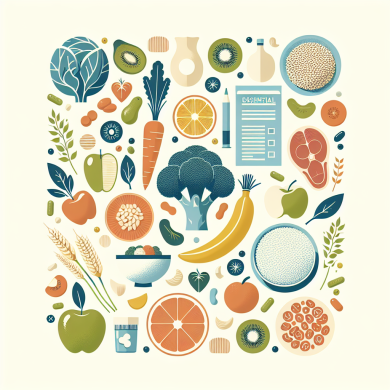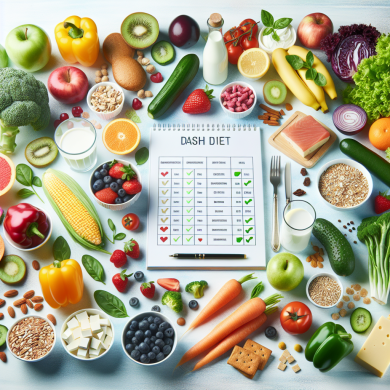DASH Diet: Boost Heart Health Naturally
Introduction to the DASH Diet
The Dietary Approaches to Stop Hypertension (DASH) diet is a heart-healthy eating plan designed to prevent and manage high blood pressure. Developed through research funded by the National Institutes of Health, the DASH diet emphasizes the consumption of nutrient-rich foods and limits foods high in saturated fat, cholesterol, and sodium. This approach is not only beneficial for heart health but also for overall wellness.
Understanding the Principles of the DASH Diet
The DASH diet focuses on a balanced intake of fruits, vegetables, whole grains, lean proteins, and low-fat dairy. It encourages the reduction of sodium intake and promotes foods high in potassium, calcium, magnesium, and fiber. These nutrients collectively help in maintaining healthy blood pressure levels.
The Role of Sodium
Reducing sodium intake is a cornerstone of the DASH diet. High sodium levels can lead to an increase in blood pressure, which is a significant risk factor for heart disease. The DASH diet recommends limiting sodium to 2300 mg per day, or 1500 mg for those with higher blood pressure concerns.
Importance of Potassium, Calcium, and Magnesium
Foods rich in potassium, calcium, and magnesium are emphasized because these minerals help balance the body’s sodium levels and support vascular health. Potassium helps to lessen the effects of sodium, while calcium and magnesium contribute to the dilation and relaxation of blood vessels.
Components of the DASH Diet
The DASH diet includes a variety of food groups that provide essential nutrients for heart health:
Fruits and Vegetables
A key component of the DASH diet is a high intake of fruits and vegetables, which are rich in potassium, fiber, and antioxidants. These nutrients help to reduce blood pressure and improve overall cardiovascular health.
Whole Grains
Whole grains such as brown rice, whole-wheat bread, and oats are encouraged because they provide fiber and essential nutrients that support heart health. Fiber aids in lowering cholesterol levels and maintaining a healthy digestive system.
Lean Proteins
The diet recommends lean protein sources like poultry, fish, and legumes. These sources provide essential amino acids without the high levels of saturated fat found in red meats.
Low-Fat Dairy
Low-fat or fat-free dairy products are included for their calcium and vitamin D content, which are important for bone and heart health.
Nuts, Seeds, and Legumes
These are excellent sources of magnesium, protein, and healthy fats. Nuts and seeds provide heart-healthy fats that can help reduce bad cholesterol levels.
Benefits of the DASH Diet for Heart Health
The DASH diet is highly effective in reducing the risk of heart disease by naturally lowering blood pressure and improving cholesterol levels.
Lowering Blood Pressure
Numerous studies have shown that the DASH diet can significantly lower blood pressure in both hypertensive and prehypertensive individuals. The combination of reduced sodium intake and increased nutrient-rich foods helps in maintaining optimal blood pressure levels.
Improving Cholesterol Levels
By emphasizing healthy fats and fiber, the DASH diet aids in reducing LDL (bad) cholesterol and increasing HDL (good) cholesterol, thereby reducing the risk of atherosclerosis and heart attacks.
Reducing Inflammation
The diet’s emphasis on fruits, vegetables, and whole grains can help decrease inflammation in the body. Chronic inflammation is a known risk factor for many cardiovascular diseases.
Additional Health Benefits of the DASH Diet
Beyond heart health, the DASH diet offers several other health benefits:
Weight Management
The DASH diet promotes a balanced intake of nutrients and encourages portion control, which can help with weight loss and maintenance. This is crucial as maintaining a healthy weight reduces the risk of heart disease and other health issues.
Diabetes Management
The diet’s focus on whole foods and low glycemic index options can help regulate blood sugar levels, making it beneficial for individuals with type 2 diabetes.
Bone Health
The increased intake of calcium and vitamin D from low-fat dairy products supports bone health and can help prevent osteoporosis.
Practical Tips for Following the DASH Diet
Transitioning to the DASH diet can be simple with some practical tips:
Start Gradually
Begin by gradually incorporating more fruits and vegetables into your meals. Replace refined grains with whole grains and opt for low-fat dairy products.
Plan Your Meals
Planning is key to success with the DASH diet. Prepare a weekly menu that includes a variety of foods from each recommended food group.
Read Food Labels
Pay attention to food labels, focusing on sodium content and choosing products with lower sodium levels.
Experiment with Herbs and Spices
Use herbs and spices to flavor your food instead of salt. This not only reduces sodium intake but also enhances the taste of your meals.
Conclusion
The DASH diet is an accessible and effective way to boost heart health naturally. By focusing on nutrient-rich foods and reducing sodium intake, individuals can significantly reduce their risk of hypertension and heart disease. With its additional benefits for weight management, diabetes control, and bone health, the DASH diet is a comprehensive approach to long-term health and wellness. By adopting this dietary pattern, you can take proactive steps towards a healthier heart and a healthier life.















Add comment